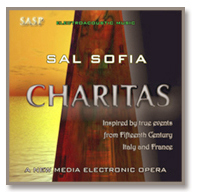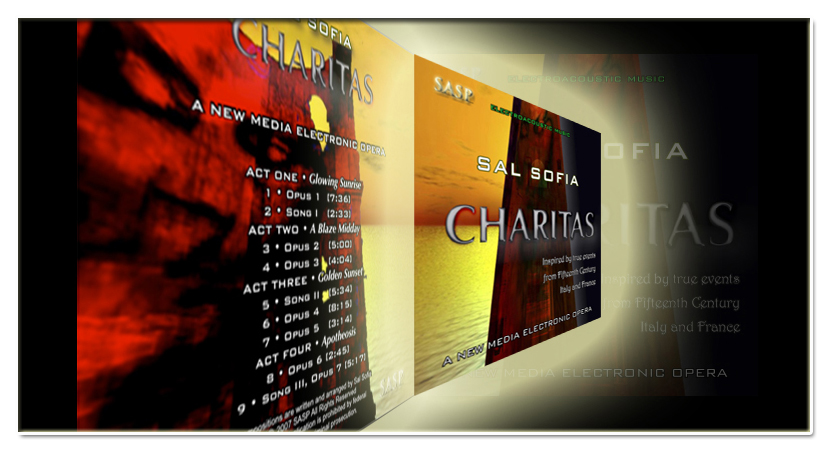
...gathering knowledge for the arts.



In this electronic opera, Sofia composes a celebration of the life of Francis of Paola, a Franciscan monk who lived in the fifteenth century and who dedicated his life to benefit mankind and the peaceful coexistence of all. The opera is adapted from the biography written by Padre Antonio Castiglione, O.M. and was conceived and realized as a multimedia composition for dancers, narration and graphics. The narration was of concern "to find the right words to support the true meaning of Charitas." Finally, while reading a book, Hinduism: A Cultural Perspective by David R. Kinsley, Dr. Sofia came across the words "that made perfect sense (even though one subject is of Christian faith and the other is Hinduism) and that fit appropriately with the music and dance." This compact disc contains the music and narration of Charitas.


Charitas, phonetically pronounced KA REE TAS, means charity, and is one of the greatest of all human virtuous traits. An agapaeic love of humankind in the Socratic sense where the "self" is only the means to the end, and fellow man and his well being are the only objects. Rarely are these individuals encountered but when they are in our midst they touch many lives, sometimes inspiring others throughout centuries with their transcending light. In this electronic opera, Dr. Sofia composes a celebration of the life of such a person, Saint Francis of Paola, a Franciscan monk who lived in the fifteenth century and who dedicated his life to benefit mankind and the peaceful coexistence of all.
Charitas (1998), the opera, is inspired from the biography, San Francesco di Paola, Vita illustrata (Rome 1977) written by Padre Antonio Castiglione, O.M. and was conceived and realized as a multimedia composition for dancers, narration and graphics. Its Premiere took place at the Walt Disney Modular Theater in 1999 and consisted of a public performance with musicians, dancers, narrator and background video images demonstrating a broad spectrum of computer music media and live performance combinations with audio and video tape/CD recordings.
The narration was of concern "to find the right words to support the true meaning of Charitas." Finally, while reading a book, "Hinduism: A Cultural Perspective" by David R. Kinsley, Sofia came across the words "that made perfect sense (even though one subject is of Christian faith and the other is Hinduism) and that fit appropriately with the music and dance." This compact disc contains the music and narration of Charitas.
The opera musically recreates certain poignant moments in the life of Saint Francis of Paola (1416-1507) that modeled his very existence as recounted in the book. Act One, is a representation of the adolescent years when he chooses to devote his life to a religious purpose. In Act Two, he is forced to leave his birthplace and beloved Italy to become the Ambassador of Peace for the Church in France. Act Three is the dramatic and tragic death of Saint Francis and Act Four celebrates how celestial charity can live on through others if they so choose.
Charitas contains Opuses and Songs used not in the traditional formal method but very much like the traditional use of recitativo and aria. Sofia's concept uses the Opuses to denote the activity going on in the opera and the Songs are a recognition of that activity. To set the stage conceptually for Charitas, stimulating sounds, such as the clip clop of horse hooves on cobble stoned streets, vocalizations, and so forth, provide imagery of the French and Italian Early Renaissance period. The Opuses were composed by utilizing sounds and musical cells composed with Csound, SoundHack, and Pro Tools. For example, the phrase "Ora Pro Nobis" was sampled, as was the water sound from running water in the kitchen sink, Plato's (Sofia's wife's cat, the Valencian) purr, et cetera...and then these sampled sounds were processed with the afore-mentioned programs. Some of the sounds in the Opuses are recurring with various modifications in the repetition, to express that every day life and nature is habitual yet each day is new. "This creates variations of the melody and motif and yet maintains the thematic and continual quality I endeavored to obtain for Charitas."
Place:
Time:
Narration: from
Narrator:
Act One
The music expresses adolescent wondering and the true promise of dedication and devotion to a religious vocation. Song I is written for Percussion, Strings, Muted Trumpet and Oboe. The Key signature is C minor in Folk style and is narrated:
"I am smaller than the minutest atom,
likewise, greater than the greatest,
I am the whole, the diversified-multicolored-lovely-
strange...universe.
I am the Ancient One.
I am...the Lord, I am the Being-of-God
(the golden germ out of which the universe unfolds).
I am the very state of divine beatitude."
Act Two
Act II recreates the manifestation of Saint Francis' life purpose. King Louis XI prevailed upon the Pope (Sisto IV) to have Saint Francis go to France as an Ambassador of Peace. And, though he is forced to leave his beloved homeland, Italy, for France he reverently performs the greatest good for mankind all through great miracles and prophesy... On his journey to France he converts the avarice, ignoble Italian King of Naples to Benevolence by convincing him to return the riches of the kingdom back to the people; and by helping a sick King Louis XI of France die a peaceful death and one worthy of the title of a Just and Noble King, Saint Francis persuaded him to return the riches he collected from his people back to his people. These acts began the "royal's" emergence from the dark (age) to the age of enlightenment, the rebirth or Renaissance, when people, art and knowledge began to flourish.
The music composition in Act Two is diverse. It begins with a wandering quality suggesting the travel that must be accomplished, a slow ponderous journey. Then, the dynamic changes to a devilish rhythm, almost danceable, ending with climaxing sound-scapes of events happening.
Act Three
Act Three recreates the events leading to Saint Francis' death, the hope and joy of returning to his homeland, Italy and then, the disappointment and realization that his fate would end in France. His death is peaceful, like the life tenet he so professed.
Song II was composed in an atonal style with the thought of creating a unique melodic string timbre and phraseological rhythms in a quasi mediteraneo style. The narration is:
"Without hands or feet am I;
of inconceivable power am I;
without eyes I see; without ears I hear;
I know all with all-pervading wisdom.
By nature detached from all am I,
and there is none who knows me.
Pure spiritual essence am I, forever."
Well, this body is now dead.
It will be carried to the funeral pyre and there reduced to ashes.
But do I die with the death of this body?
Is the body I?
It is silent and inert; but I feel the full force of my personality and
even the voice of the "I" within me, apart from it.
So I am the Spirit transcending the body.
The body dies but the Spirit that transcends it cannot be touched by death.
That means that I am the deathless Spirit."
Act Four
Saint Francis is united with God and is renowned all over the world for the goodness he saw in all mankind.
The score for Song III was written for lutes however the instruments employed for the music output were Piano, Strings, Tenor Sax, Guitars and Trumpets. The style of the composition is atonal and also recorded as a canon (an afterthought) to symbolize that even though we are from different races and cultures, most of us want the same things from Life e.g. Peace, Love, Harmony. Song III is narrated:
"I am free from passion and similar taints.
Suffering, a body, and other limiting peculiarities are not with me.
I am the Self, the Only-lonely-one,
which is comparable to the infinite sky.
So I am the Spirit transcending the body.
The body dies but the Spirit that transcends it
cannot be touched by death.
That means I am the deathless Spirit."
A note of interest that brings this account full circle is that Francis' influence was so great upon the reign of King Louis XI that one of the royal families named their son after the benign Saint. As fate would have it, this royal son became the King of France, King Francis the First, and was a great patron of the Arts. During his reign he encouraged the renowned painter, Leonardo DaVinci, to leave Italy and go to France. DaVinci brought many of his greatest paintings with him to France, including the Mona Lisa, where they remained after his death. Benevolent Charity and Goodness has the longest reaching and most surprising effects upon mankind.
Dr. Sal Sofia received a Doctorate in Musical Arts in Composition for Computer Music from the University of Washington, Seattle, a Master of Fine Arts in Composition and New Media from California Institute of the Arts, Valencia and a Bachelor of Arts in Music Science and Technology from the University of Northern Iowa, Cedar Falls.